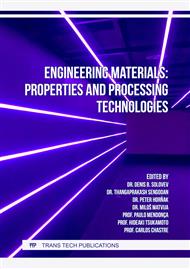[1]
A. Berlin, S.A. Vol'fson, V.G. Oshmyan, N.S. Enikolopov, Principles of Creation of Composite Polymeric Materials, Khimiya, Moscow, 1990.
Google Scholar
[2]
A. Kolosova, E. Pikalov, O. Selivanov, Heat-Insulating Composite Material Based on Wood and Polymer Waste, Ecology and Industry of Russia. 24, № 2 (2020) 28-33.
DOI: 10.18412/1816-0395-2020-2-28-33
Google Scholar
[3]
M.L. Kerber, V.M. Vinogradov, G.S. Golovkin, Polymer composite: structure, properties, technology: schoolbook, Eds. A.A. Berlin. Spb.: Profession, 2008, p.536.
Google Scholar
[4]
V.Y. Chukhlanov, T.A. Trifonova, O.G. Selivanov, M.E. Ilina, N.V. Chukhlanova, Thin-film coatings based on hollow inorganic microsheres and polyacrylic binder, International Journal of Applied Engineering Research. 12, №7 (2017) 1194-1199.
Google Scholar
[5]
V.Yu. Chukhlanov, O.G. Selivanov, Electrical properties of syntactic foams based on hollow carbon microspheres and polydimethylsiloxane, Russian Physics Journal. 59, №7 (2016) 944– 948.
DOI: 10.1007/s11182-016-0858-9
Google Scholar
[6]
L. Bardella, F. Genna, On the elastic behavior of syntactic foams, International Journal of Solids and Structures. 38 (2001) 307-333.
DOI: 10.1016/s0020-7683(00)00228-6
Google Scholar
[7]
E. M. Wouterson, F.Y. Boey, X. Hu, S.C. Wong, Specific properties and fracture toughness of syntactic foam: Effect of foam microstructures, Composites Science and Technology. 65 (2005) 1840–1847.
DOI: 10.1016/j.compscitech.2005.03.012
Google Scholar
[8]
V.Yu Chukhlanov, O.G. Selivanov, Thermophysical properties of syntactic plastic foams based on polydimethylsiloxane binder, International Polymer Science and Technology. 43, №3 (2016) 39-41.
DOI: 10.1177/0307174x1604300308
Google Scholar
[9]
A.S. Torlova, I.A. Vitkalova, E.S. Pikalov, O.G. Selivanov, Recycling of ceramic and polymeric wastes in the production of surfacing composite materials, Ecology and Industry of Russia. 23, №7 (2019) 36-41.
DOI: 10.18412/1816-0395-2019-7-36-41
Google Scholar
[10]
J. Anthony, Jr. O'Lenick, Silicone Polymers: New Possibilities in Nanotechnology, American Chemical Society, Symposium Series. 96 (2007) 165-175.
Google Scholar
[11]
J.R. Fried, Polymers in Aerospace Applications Reviews. 16, №12 (2008) 137-142.
Google Scholar
[12]
A. Torlova, I. Vitkalova, E. Pikalov, O. Selivanov, Development of Polymer Composite Facing Material Using Anthropogenic Waste, Advances in Intelligent Systems and Computing. 1116 (2020) 544-551.
DOI: 10.1007/978-3-030-37919-3_54
Google Scholar
[13]
P. Bunn, J.T. Mottram, Manufacture and compression properties of syntactic foams, Composites. 24, №7 (2013) 565-571.
DOI: 10.1016/0010-4361(93)90270-i
Google Scholar
[14]
S. Kenlg, J. Raiter, M.- J. Narkis, Cell. Plast. 21 (1984) 423-427.
Google Scholar


